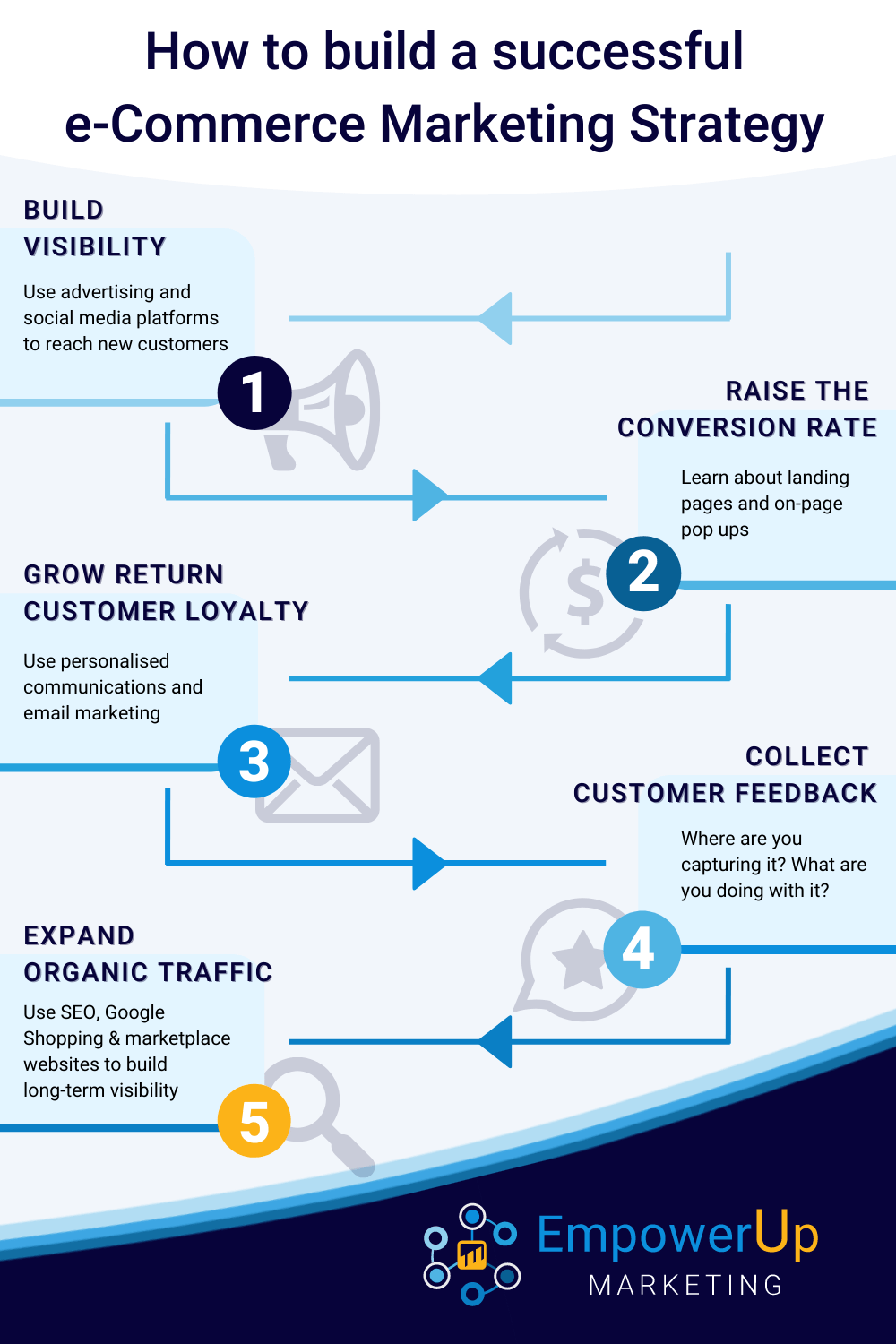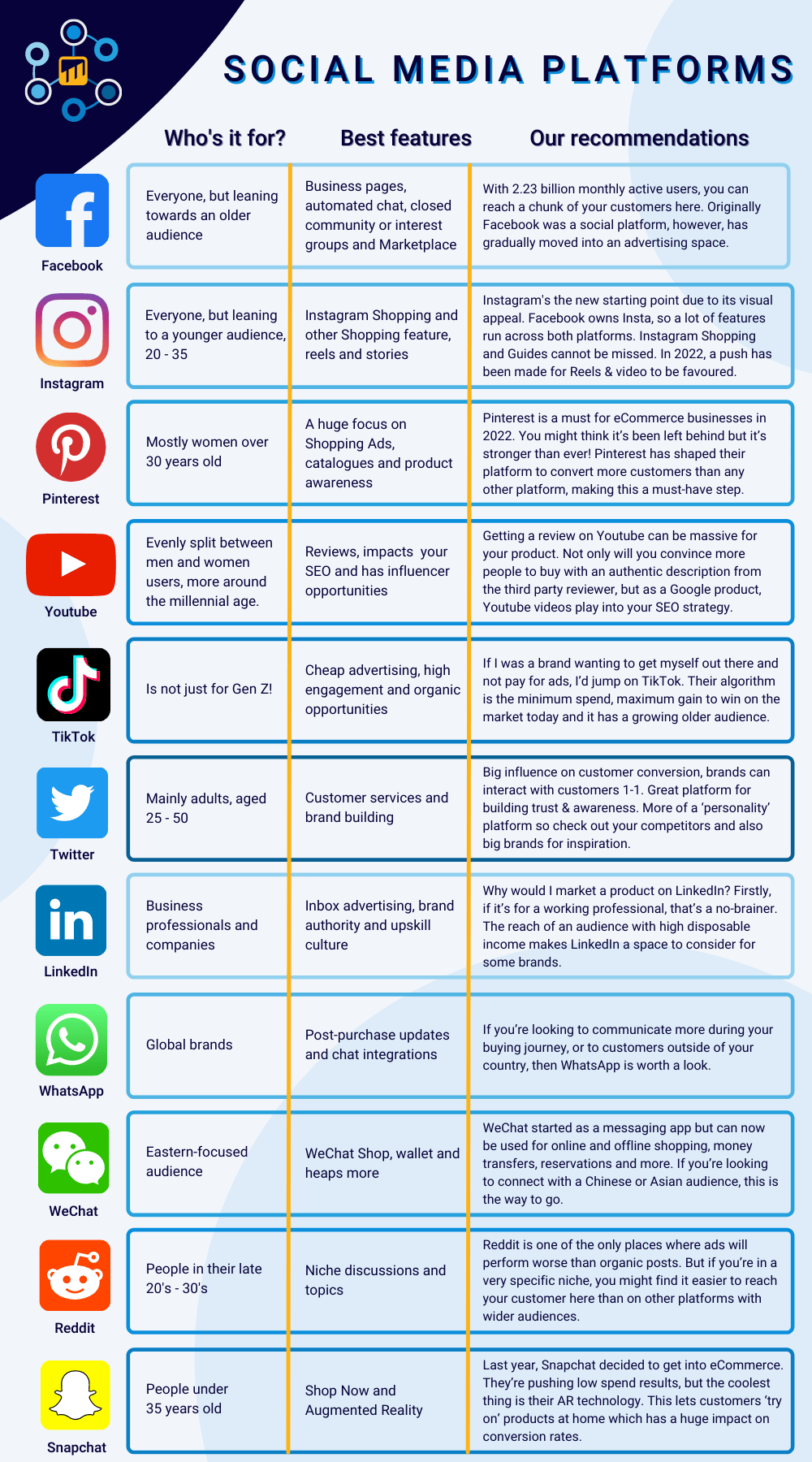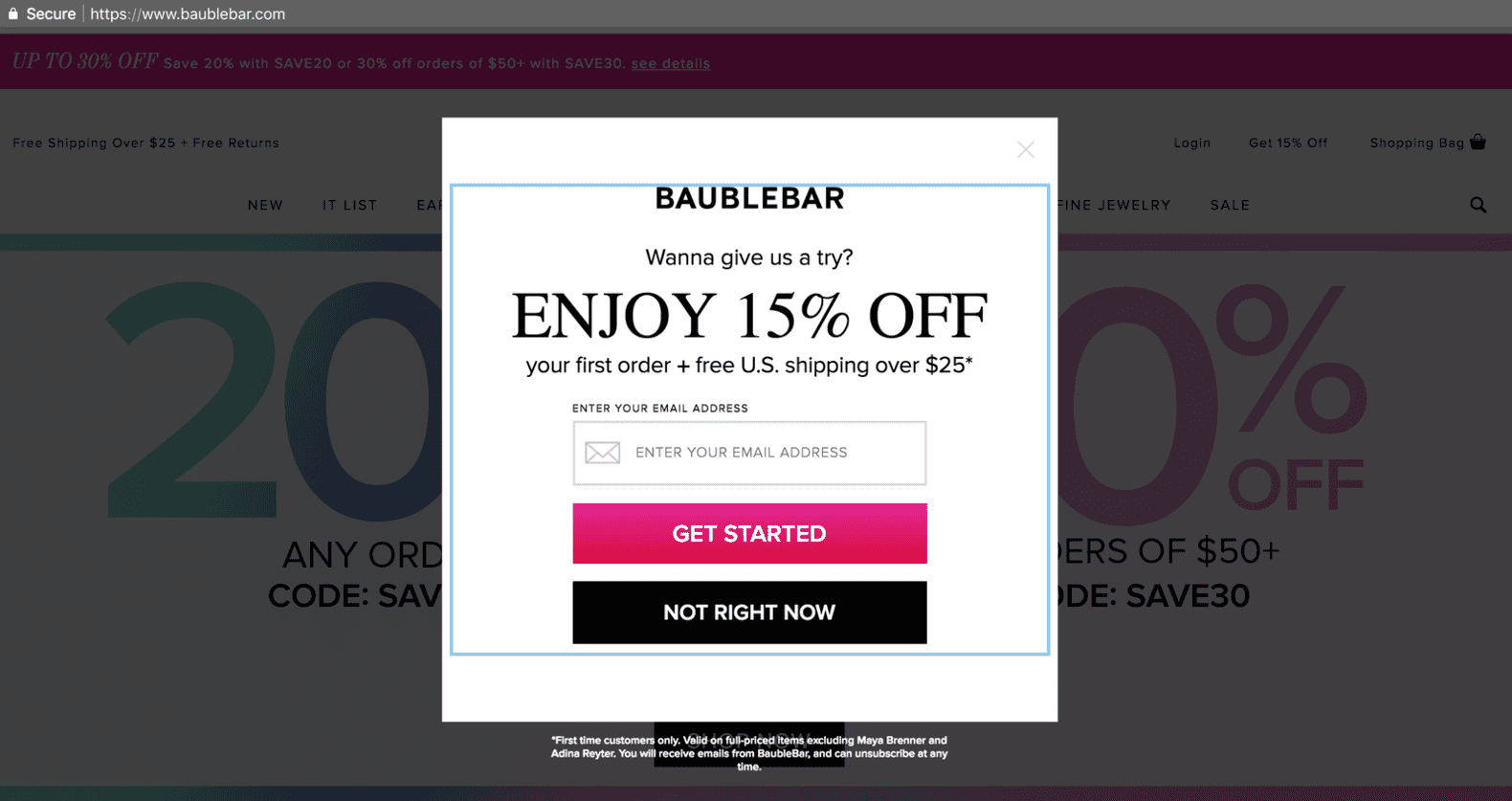How to get started with eCommerce marketing
We all know digital marketing is essential to any successful eCommerce business. Why? Because you could have the greatest product in the world to sell, but without marketing, no one is going to know it exists! Strategic eCommerce marketing can provide your business with a steady flow of targeted customers, reduce the cost per customer acquisition over time, and much more.
We’ve written this beginner’s guide to help you get started with eCommerce marketing. You’ll find a step-by-step plan showing you how to start promoting your online store, what steps you need to take to make your store profitable, and how to develop an eCommerce marketing strategy that works for you.
Table of Contents
The 5 key elements that make a successful eCommerce marketing strategy
As much as we would all love for this to happen, posting randomly on social media platforms just doesn’t get results the way we want. An eCommerce specific marketing strategy is crucial for any eCommerce business that wants to succeed in the digital world. When we talk about a marketing strategy, it’s not meant to sound overwhelming! It’s simply a plan that helps you understand your goals and objectives, as well as the steps you need to take to achieve them.
The key elements of an effective eCommerce marketing strategy include:
A clear understanding of your target audience and what they want from your company
Take the time to define and understand your ideal customer. The most important thing here is to start with what you’re expecting, but adapt this profile over time with the information you have available. No part of your marketing strategy should ever be ‘set and forget!’
Top Tip: Once you’ve created this part of your strategy, set yourself calendar reminders quarterly to revisit your ideal customer profiles. Add in new data insights, things you have learnt and even case studies to develop these profiles further.
A well thought out social media strategy that will help grow your brand on different platforms
Don’t just go where you use social media personally and think you need to post. Try platforms that resonate with your target audience, and take the time to learn about the specific opportunities of that platform.
Did you know? People on Pinterest spend 2x more than people on other platforms.
A clear call to action for both online and offline customers, so they know what to do when they are ready to buy something from you
Nothing is ever as obvious as it seems. Everything you do, from posts to pop-ups to personal emails needs to have a clear call to action if you want people to take action. A smart eCommerce marketing strategy will not only feature purchase-driven CTAs on your website but also include a newsletter or offer sign ups to capture customer information so you can continue to market to them personally and drive sales.
A professionally branded website built for converting your customers
In today’s digital space, anyone can build a website. Unfortunately, that doesn’t mean everyone should. Your website needs to be professional looking to build trust with your branding consistent across all your digital platforms. A good online store isn’t just built to show products, it’s designed to take customers on a journey to the checkout and increase your conversion rates.
What makes a website 'professional?'
- No obvious errors
- Consistent use of colours and design elements
- A user-focused interface
- Built for mobile
- High-quality imagery
- Speedy load times
Integrating a loyalty program into your marketing strategy, so customers feel like they are getting something extra for their purchase
Offering a first-time purchase discount code isn’t exceptional service anymore, it’s the service norm. Your products should be priced with enough margin that allows you to regularly offer discounts and promotions to customers. The eCommerce space is highly competitive so factor your maximum discounted price into your product costs. Create loyalty by engaging with reviews and personalising communications.
Awesome, now with all that in mind, how do we get started? For this article, let’s assume you already know who your audience is because that’s a guide in itself. We’re going to break down step by step the activities you should do to build a successful eCommerce marketing strategy in this helpful infographic below.

Step 1: Building Visibility
Ok, so you have your website up and running, and your products are ready to ship. What are we missing… the customer! In many ways, this can seem like the hard part. You know your product and you know who your customers are, but using the digital space to find them is a whole other thing. Don’t worry – we’ll help you determine how to build visibility in the right spaces to start generating some hype for your business.
The Pros and Cons of paid advertising for your eCommerce store
Every eCommerce store owner is looking for the best way to promote their products. There are many different ways to do that, but paid advertising is one of the most popular.
The pros of paid advertising for your eCommerce store are:
- You can reach a wider audience with your ads,
- You can target people who are more likely to buy what you’re selling,
- Your ads will be seen more often because they’re constantly being shown on different sites.
The cons of paid advertising for your eCommerce store are
- It costs money,
- It takes a lot of time to set up and monitor the ads,
- You need to know what kind of ads will work best with your marketing or be willing to learn through trial and error.
Advertising platforms are designed to very ‘do it yourself’, but we’d recommend caution if you are jumping in without a plan. Consult with a professional – at least just to get started – and you’ll be able to generate better results than cover that early investment.
Social media engagement and ads
Social media have become an integral part of any marketing strategy. With the number of social media platforms available, it’s important to know which one is best for your business and what type of ads you should be running. Popular social media platforms include:

So in summary, social media is a powerful tool for businesses to reach their target audience and create a following. Finding the right platform is a great way to share information about your company, products and services and engage customers. You might find that where you place your ads to capture your audience’s attention might surprise you when compared to your organic engagement on those same platforms.
Another Great Way to Market Your eCommerce Business is through Influencer Marketing!
Influencer marketing is an advertising technique that relies on influential people to promote products. It helps customers to trust your brand by associating with someone they admire.
Influencer marketing is one of the most effective ways to increase sales. It has been proven to be a more affordable and less invasive way of reaching potential customers. It also helps brands avoid being associated with negative publicity – they don’t need to worry about their ads getting blocked by ad blockers, for example.
There are many benefits of influencer marketing and it’s worth considering for your business, especially if you’re looking for a new strategy. Use hashtags and terms you associate with your business to find the right influencers, and set up unique promotional codes to track which ones generate the most sales.
Some influencers, particularly micro-influencers with a smaller following, may share your product for a free sample, others will require payment, but you can find out the influencer’s terms by reaching out and starting a conversation.
Now, influencer marketing has been the scrutiny of the media the last few weeks (March 2022) with recent legislation and changes to how influencers can conduct their business with specific products in health and wellness industries. No matter what type of product you are selling, make sure that you have researched legal obligations for your influencer marketing scripts!
Step 2: Raising your conversion rate
Ok, awesome, we have now found the customer and they’ve clicked through to your website. What happens next? Are they landing on the product or a custom landing page? Do you have pop-ups set up to capture users’ information to help build your sales funnel?
Landing Pages and Pop-Ups
A landing page is the web page displayed when someone clicks on a link on a social media post, search engine result or advertisement. Landing pages are often used as a marketing tool to promote products or services and include all the relevant information plus a strong call to action, specific to that ad. Rather than the product page or a page from your website, your landing page is designed to show that specific user why they should purchase your product.
For example, you might have an informational landing page that highlights your unique selling points, such as a list of your sustainability initiatives for an environmentally friendly brand. You may set up a customised product category page to use as a landing page that highlights a specific body type or fashion trend. It’s an opportunity to highlight to your customers what you can offer them that speaks directly to their specific needs and wants.
Did you know? Addressing buyer fears on landing pages can increase conversion rates by 80%!
Pop-ups can be seen as an interruption to the user’s browsing experience, but they can also be used to make the user stay on the website longer and increase their chance of a conversion. We recommend using pop-ups to capture exit intent (someone leaving your store before making a purchase). Offering someone a first-time purchase code reminds them to purchase the product. This is also where you can ask for their email details and be able to add them into an email marketing campaign that keeps them engaged longer.
Remember, between waiting for payday and everyday distractions, there are a lot of opportunities for your customer to fully intend to shop with you but simply forget. Capturing their details and following up is an important step in eCommerce marketing to maximise your sales!
Step 3: Building your loyalty
Email marketing for eCommerce growth
Email marketing is one of the most direct channels that businesses can use to promote their products. It is also one of the most cost-effective methods to get in touch with your customers and grow your business. At EmpowerUp Marketing, we love email because it’s a platform that you can own. You get to control when and what is sent to your customers, rather than hoping a social media platform’s algorithm carries your content to the right people.
With ads, you’re often reaching out to cold customers whereas people receiving emails have at least shown some interest in your business, either through visiting your website and leaving an email address or through a previous purchase.
While we are chatting about email marketing... 😉
Learning a lot? Join our newsletter for even more tips and tricks covering all things business marketing.
Subscribe To Our Newsletter
Some brands may choose to only send a monthly newsletter, while others may use their email platform for promotional campaigns. Regardless of the frequency, email marketing can be used as a tool for customer retention and loyalty programs.
For eCommerce businesses, the best practice is to include campaigns such as abandoned shopping carts, discounted follow up purchases, related product recommendations or birthday promotions to connect with customers and increase sales. This involves building out a customer journey sequence with all the right automation and steps but is well worth it in the long run.
Step 4: Collecting customer feedback
Customer reviews are content gold!
Collecting customer feedback is not a good way to improve your products and services… it’s GREAT! It’s important to know what your customers want so that you can improve on the things they don’t like. The tricky balancing act here is that you want to act with integrity and collect genuine feedback. You want to actually take actions from this feedback, whilst also transparently displaying it to show your trustworthiness to customers in a way that doesn’t feel staged.
Don’t worry, it’s totally doable. Some of the ways eCommerce businesses use customer feedback in their marketing strategy can include:
Requesting feedback in the form of customer reviews. Make sure to include easy to follow links in your email marketing to high visibility channels. If you lean into a social media led marketing strategy, direct reviews to Facebook reviews. If your customers tend to search for you, then a Google My Business profile is your best friend.
Asking at the right time. If you’re going to request reviews that are visible to the world, pick your timing. Ask when a customer is at their happiest, this is usually right after the time of receiving the goods or services they have purchased.
Engage with your customer’s feedback. If someone takes the time to leave you a review, ensure you respond to it in a timely manner with either thanks for their recommendation for your business, or with action points regarding how you intend to address their concerns.
Do not feed the trolls. If you receive unwarranted or unexpected negative feedback, stay professional and do not rise to meet any taunting or other negative language use that could deter future customers. Every single response you post, your potential customers will be seeing – never forget this!
Create a conversation online. Use your own content marketing to engage with customers and encourage them to talk about your business to their own followings. Whilst we touched on influencer marketing earlier, don’t undervalue the positive word of mouth from your everyday customers! Stories on Instagram and Facebook are a great way to capture this.
Step 5: Google Shopping and marketplace opportunities
Why you need to focus on 'marketplace' in your eCommerce marketing strategy
Google Shopping is not just a place for advertisers to buy ads. It’s also a place for businesses to sell their products to shoppers. With Google Shopping, you can reach shoppers across devices and platforms, including desktop computers, smartphones, tablets, and smartwatches.
Google Shopping is one of the best ways to promote your products in front of people who are actively looking for what you have to offer. And it’s easy too! You can set up Google Shopping in minutes by following these steps:
Get your product feed ready – you can either do this manually or (ideally) by connecting the Google Merchant Centre to your eCommerce platform so product information is automatically kept up to date.
Connect your feed with Google Ads – ‘organic’ shopping is a relatively new space, but the platform is still primarily catering to paid promotion. Work out your best selling product lines and where you can stand to profit after factoring in your ad spend.
Track performance – as with any marketing campaign, it’s not just about the set-up but the ongoing learning and maintenance. Monitor daily and make adjustments based on what works and what doesn’t monthly. Try to fight the urge to change things daily, as you won’t get a clear picture of how your campaign is going.
With Google Shopping, Amazon and other marketplaces becoming more competitive, it is important to have an effective eCommerce marketing strategy to stay ahead of the competition. The key is understanding where your customer is searching for products and focusing on those spaces instead of trying to do everything.
If you’re in a niche that has a swing towards a specific marketplace rather than a general space like Amazon or eBay, you’re likely to see better conversion rates dedicating time to your unique opportunities. That isn’t to say there isn’t value in being present in multiple marketplaces, but it comes down to what resources you have available.
Almost done!
What an overload of information! Time to digest all that you’ve just learnt. This is a great starting point to think about what you’re doing now and what you need to invest to be competitive in the eCommerce industry.
So, why did you click on this article and what are you looking for?
You might already do a handful of things we’ve mentioned and be looking to bridge a few gaps or handle some technical elements. Perhaps you’re looking to get started with a bang and have a professional marketing team to help you tackle a larger marketing goal. Or maybe you don’t have time to handle marketing on top of your day-to-day business activities.
Hello! We are EmpowerUp Marketing and we provide digital marketing solutions to businesses in a range of services.
We offer ad hoc, single quote services to fortify your overall marketing activities, fantastic combinations of marketing activities in a package, and affordable custom monthly retainers to be your dedicated marketing support. Have confidence in outsourcing activities to professionals and focus on building your business.
If you have any questions about eCommerce marketing or you’re not sure if you know you want to explore your options but have no idea where to start, send us a message with the enquiry form below and we’ll be happy to help in any way we can!



